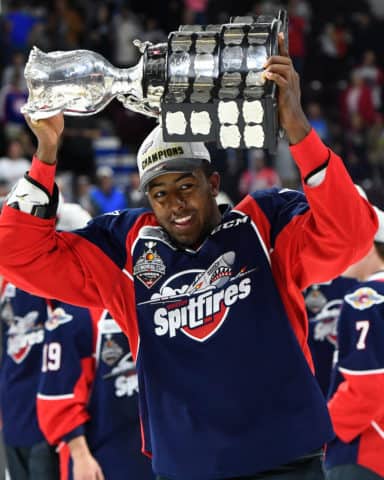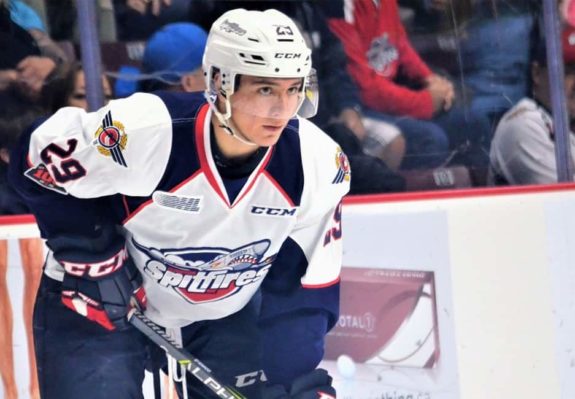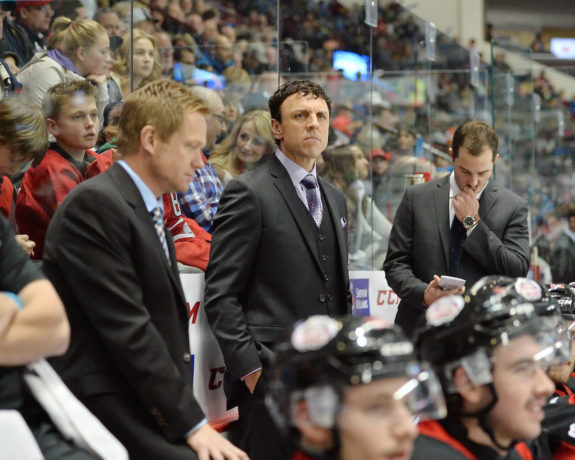The OHL Christmas Break has wrapped up and the Windsor Spitfires are preparing for drastic changes. While the team had a successful first half, they enter the second half with some uncertainty. There will be some storylines to keep an eye on as the season rolls along.
During the first half, the big question was whether the team would rebuild or go for a second Memorial Cup title. It was answered in early December, as captain Aaron Luchuk was dealt to the Barrie Colts for 17-year-old Curtis Douglas and picks. This is likely to create a domino effect with veterans being shipped out before the Jan. 10 trade deadline.
The team will likely rely on their youth to maintain their playoff spot (currently fourth in the Western Conference, 11 points up on the ninth-place Erie Otters). It won’t be easy, though.
As we head into the second half, here are five stories to watch for as the march towards the playoffs begins:
1. Trade Deadline Chaos
As mentioned earlier, the Luchuk deal is likely the first domino to fall in the big rebuild. How far will it go, though?
With players such as Logan Brown, Sean Day, Michael DiPietro and even 20-year-olds Austin McEneny and Jake Smith being discussed as bait, fans might need to buy a program come Jan. 11 (first game after deadline). The Spitfires have a limited number of player cards available, so they can’t just trade for whoever they want. However, expect general manager Warren Rychel to use those cards wisely and swiftly.
There’s also the situation with draft picks. The Spitfires have no second-round picks until 2021 and no thirds until 2023. Expect picks to be shipped to the WFCU Centre by the truckload with Rychel’s name all over the shipping labels.
This is going to be a big part of the Spitfires season and could easily play a part in how the next couple of years unfold.
2. Cole Purboo Continuing Consistency
Forward Cole Purboo has been a strange case for the Spitfires ever since he signed prior to the 2016-17 season. He started his rookie season off red-hot, but quickly cooled and struggled on many nights. His skating wasn’t there and he shied away from using the body.
Something has changed this season, though.

Coming off a 17-point season, the first half this season saw Purboo explode for 11 goals and 31 points in 32 games. Not only are his points up, but his overall game has become night-and-day. There was remarkable work put into his foot speed in the offseason and his willingness to use his 6-foot-3, 215-pound frame certainly doesn’t hurt.
Purboo had a taste of the top line with Brown and Luchuk earlier in the season. After the deadline, it wouldn’t be a surprise to see him become a fixture there. He needs to maintain the consistency we saw in the first half if the Spitfires offence is to continue producing. The talent is there. The confidence should be there. Can he put it all together for the full season, though?
3. Recharging Michael DiPietro
During the first half, we saw that DiPietro is only 95 percent robot. While the starting goaltender was his usual all-star-like self, there were moments where he looked merely above-average. At one point in November, he had allowed four or more goals in five straight games. That’s simply not normal.
One huge factor could simply be fatigue. He’s played in 29 of Windsor’s 32 games so far and that’s an incredible workload for any goaltender. Here’s one of those games, where DiPietro recorded a shutout against the Oshawa Generals:
Things need to change in the second half. Not only for DiPietro, but for the backups Brock Baier and Lucas Patton, too. The two 18-year-old goaltenders have split the already-sparse work and, assuming DiPietro isn’t traded at the Jan. 10 deadline, something has to give.
If you gave DiPietro the keys to the crease every game, he’d gladly take them. That’s not the safe move, though. Baier and Patton need more ice time and DiPietro needs to recharge the batteries more often.
For the Spitfires to maintain success in the second half, the Spitfires need all goaltenders on the top of their game. This means more ice for the backups and more time at the charging station for DiPietro. It would give the backups much-needed playing time to develop their craft, while DiPietro rests up to ensure a solid March performance.
4. Sustained Secondary Scoring
Earlier in the season, the duo of Luchuk (before his deal to the Barrie Colts) and Brown had been the primary force for the Spitfires up front. As the season has gone along, though, others have found their game.
The aforementioned Purboo, along with 17-year-old Mathew MacDougall, 18-year-old Luke Boka and the 17-year-old Douglas will be the primary focus for the Spitfires’ offence up front.
MacDougall had a strong first half with 20 points in 31 games while Boka wasn’t far behind with 20 points in 29 games. Douglas is a 6-foot-8, 234-pound power forward who has 20 points in 30 games between the two teams.
More will also be expected from rookies Kirill Kozhevnikov, who was taken in 2017 CHL Import Draft, and Daniel D’Amico, who has six points in 25 games in fourth-line duty.

There is likely to be more expected from the blueline scoring, too. Rookies Lev Starikov and Nathan Staios have shown flashes of offensive potential, as has sophomore Connor Corcoran. If Day is traded, these youngsters will be thrown into the fire. They’ve shown they can handle it so far but must sustain that in the second half for team success.
No team can rely on just two guys to provide the bulk of their offence. Being able to roll three or four lines every night with comfort is the goal. If you want to maintain success, you need scoring from all parties.
5. Build the Chemistry
This will be a very important situation in the second half.
When you’re rebuilding a team, developing chemistry and team unity is mandatory. You need everyone on the same page as, if done properly, it could create a club that wins for multiple seasons (see: Erie Otters).
Once the trades are made and the roster is finalized, it’s a matter of chemistry and finding a way to become one unit. Head coach Trevor Letowski has done wonders so far and his expertise will be needed the rest of the way.

One of the reasons Luchuk and Brown had such great chemistry before Luchuk’s deal was they had played together for three seasons. They knew each other like nobody else. Bonding on-and-off the ice will go a long way towards capturing another Memorial Cup in the future.
The next two weeks won’t be easy for the team with players moving in-and-out. After that, though, it’s all about creating for the future.